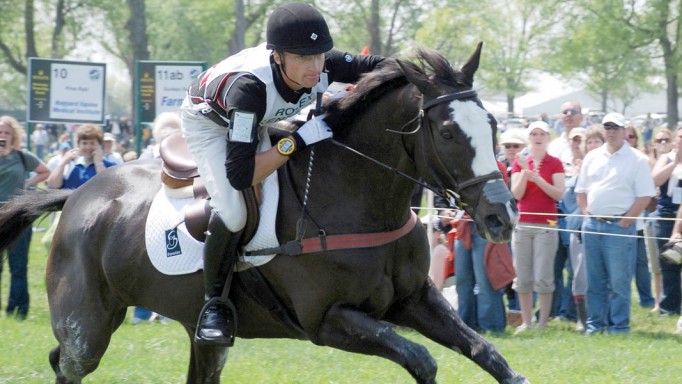Here’s what 2007 Pan Am team silver medalist and five-time Royal Agricultural Winter Fair indoor eventing champion Waylon Roberts suggests for developing a feel for the right pace.
“It’s about learning through experience. You must be able to make the horse go forward and come back and be able to control every stride. You don’t want to have to constantly kick to keep going, or get run away with. You want the horse in a stride and rhythm that carries it efficiently across the ground.
At home, find an area where you can gallop. Measure out 450 metres and ride it at a gallop. See if you can cover that distance in one minute. That’s training level pace. If you only have 225 metres available, see if you can ride the distance in half a minute. For other levels, check your omnibus (see chart) and figure out what speed and distance you should work towards.
Some horses feel like they are going slower than they really are, but have a bigger stride and are covering more ground. The more you practice the gallop and the better you know your horse, the better sense you’ll develop for pace.
Wear an equestrian stop watch when you school. Some people try using wrist watches, but the numbers are difficult to see. When you are competing, you don’t want to distract from your ride by bringing your hand up to your face. Make sure you know how your stop watch works before you go to a show.
At the entry level, you aren’t allowed to use a stop watch in competition and that’s okay. You want to concentrate on the quality of jumping and not be overly concerned about making the time. It’s more important to give your horse confidence about jumping around the course. At the lower levels, I let my young horses go at a pace they are comfortable at to build their confidence.
You are not going to be travelling at the same galloping speed throughout an entire course. Some places, you may be going at 500 metres a minute and others at 200 metres per minute. A twisting, turning course makes it feel like you are going faster than you are. The more pulling you do, the slower you’ll be, while a horse running too fast is breaking the rhythm.
A course where jumps come up faster will ride differently than a course that has longer distances between fences. A CIC will have shorter distances but a higher intensity of jumps, while a CCI will be longer with greater distances between obstacles.
Study the course during the course walk and discuss strategy with your coach. Figure out the places you can gallop forward. For banks, water jumps or technical questions, you must be able to come back to a slow, stadium jumping-style canter.
I start my stop watch 10 seconds before I leave the start box. I check it after the third or fourth fence to determine what pace I’ll need. I try to limit myself to checking my watch four times on a training course. Check your watch halfway through to see if you’re close to optimum time.
Towards the end of the course, if you are going too fast, don’t simply jump the last jump, come to a walk and go through the finish line; you will be penalized for that. Instead, use the last three jumps to slow your pace.”

